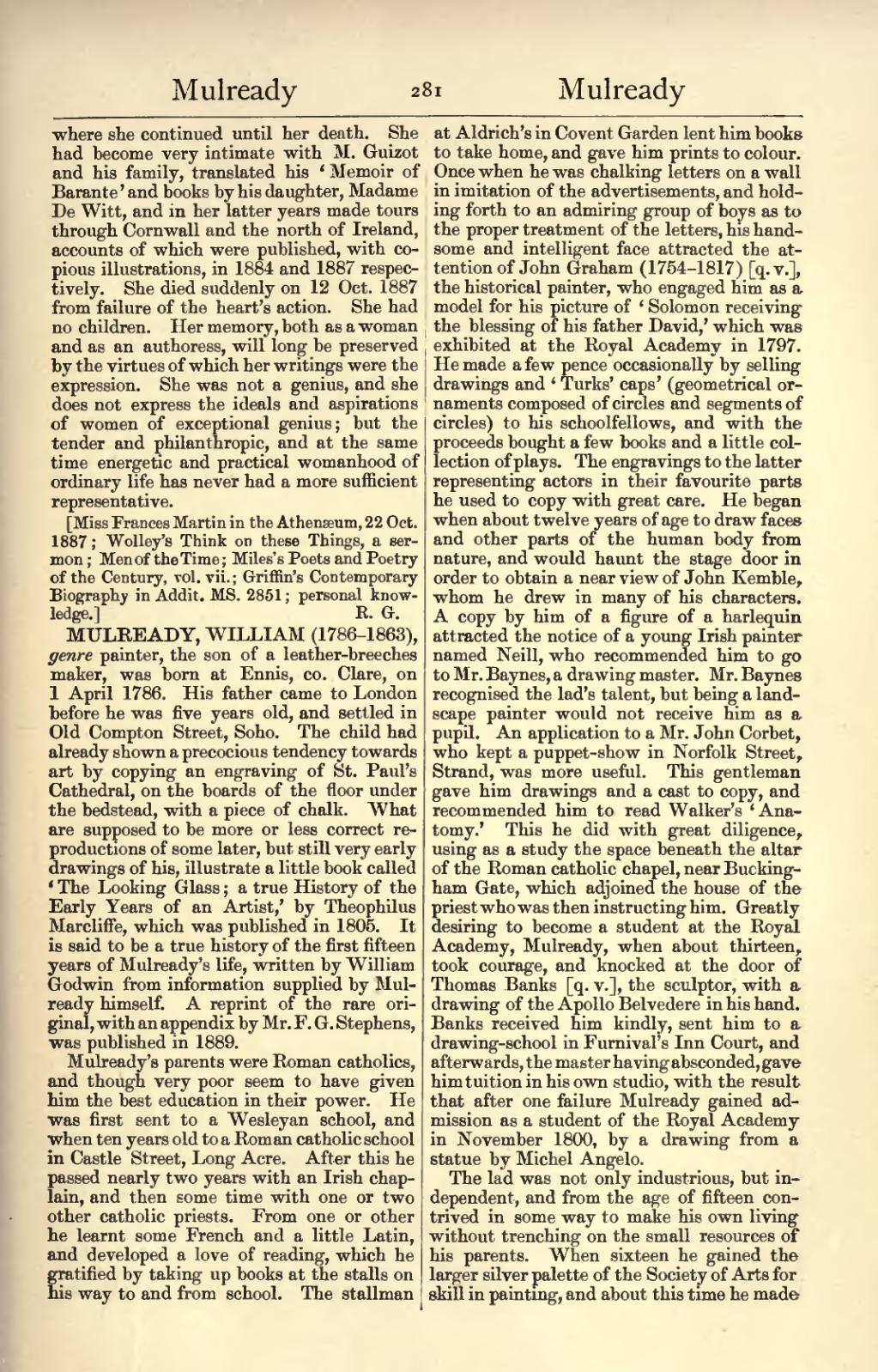where she continued until her death. She had become very intimate with M. Guizot and his family, translated his 'Memoir of Barante' and books by his daughter, Madame De Witt, and in her latter years made tours through Cornwall and the north of Ireland, accounts of which were published, with copious illustrations, in 1884 and 1887 respectively. She died suddenly on 12 Oct. 1887 from failure of the heart's action. She had no children. Her memory, both as a woman and as an authoress, will long be preserved by the virtues of which her writings were the expression. She was not a genius, and she does not express the ideals and aspirations of women of exceptional genius: but the tender and philanthropic, and at the same time energetic and practical womanhood of ordinary life has never had a more sufficient representative.
[Miss Frances Martin in the Athenæum, 22 Oct. 1887; Wolley's Think on these Things, a sermon; Men of the Time; Miles's Poets and Poetry of the Century, vol. vii.; Griffin's Contemporary Biography in Addit. MS. 2851: personal knowledge.]
MULREADY, WILLIAM (1786–1863), genre painter, the son of a leather-breeches maker, was born at Ennis, Co. Clare, on 1 April 1786. His father came to London before he was five years old, and settled in Old Compton Street, Soho. The child had already shown a precocious tendency towards art by copying an engraving of St. Paul's Cathedral, on the boards of the floor under the bedstead, with a piece of chalk. What are supposed to be more or less correct reproductions of some later, but still very early drawings of his, illustrate a little book called 'The Looking Glass; a true History of the Early Years of an Artist,' by Theophilus Marcliffe, which was published in 1805. It is said to be a true history of the first fifteen years of Mulready's life, written by William Godwin from information supplied by Mulready himself. A reprint of the rare original, with an appendix by Mr. F. G. Stephens, was published in 1889.
Mulready's parents were Roman catholics, and though very poor seem to have given him the best education in their power. He was first sent to a Wesleyan school, and when ten years old to a Roman catholic school in Castle Street, Long Acre. After this he passed nearly two years with an Irish chaplain, and then some time with one or two other catholic priests. From one or other he learnt some French and a little Latin, and developed a love of reading, which he gratified by taking up books at the stalls on his way to and from school. The stallman at Aldrich's in Covent Garden lent him books to take home, and gave him prints to colour. Once when he was chalking letters on a wall in imitation of the advertisements, and holding forth to an admiring group of boys as to the proper treatment of the letters, his handsome and intelligent face attracted the attention of John Graham (1754-1817) [q. v.], the historical painter, who engaged him as a model for his picture of 'Solomon receiving-the blessing of his father David,' which was exhibited at the Royal Academy in 1797. He made a few pence occasionally by selling drawings and ' Turks' caps' (geometrical ornaments composed of circles and segments of circles) to his schoolfellows, and with the proceeds bought a few books and a little collection of plays. The engravings to the latter representing actors in their favourite parts he used to copy with great care. He began when about twelve years of age to draw faces and other parts of the human body from nature, and would haunt the stage door in order to obtain a near view of John Kemble, whom he drew in many of his characters. A copy by him of a figure of a harlequin attracted the notice of a young Irish painter named Neill, who recommended him to go to Mr. Baynes, a drawing master. Mr. Baynes recognised the lad's talent, but being a landscape painter would not receive him as a pupil. An application to a Mr. John Corbet, who kept a puppet-show in Norfolk Street, Strand, was more useful. This gentleman gave him drawings and a cast to copy, and recommended him to read Walker's 'Anatomy.' This he did with great diligence, using as a study the space beneath the altar of the Roman catholic chapel, near Buckingham Gate, which adjoined the house of the priest who was then instructing him. Greatly desiring to become a student at the Royal Academy, Mulready, when about thirteen, took courage, and knocked at the door of Thomas Banks [q. v.], the sculptor, with a drawing of the Apollo Belvedere in his hand. Banks received him kindly, sent him to a drawing-school in Furnival's Inn Court, and afterwards, the master having absconded, gave him tuition in his own studio, with the result that after one failure Mulready gained admission as a student of the Royal Academy in November 1800, by a drawing from a statue by Michel Angelo.
The lad was not only industrious, but independent, and from the age of fifteen contrived in some way to make his own living without trenching on the small resources of his parents. When sixteen he gained the larger silver palette of the Society of Arts for skill in painting, and about this time he made

